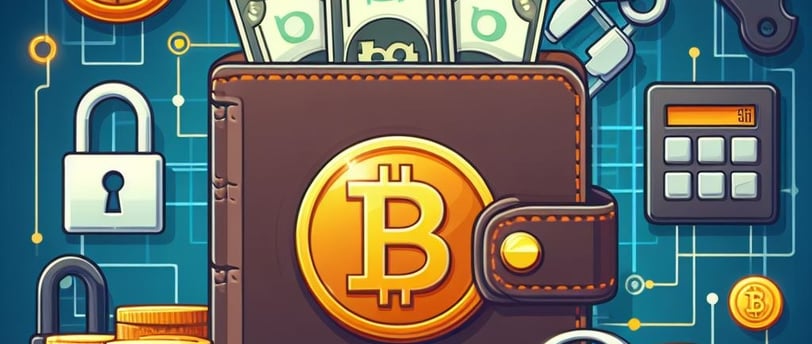How to Secure Your Cryptocurrency Wallet: Best Practices for Protecting Your Digital Assets


Introduction
In the world of cryptocurrency, security is of utmost importance. With the increasing popularity and value of digital assets, it is essential to take measures to protect your cryptocurrency wallet from theft and hacking. In this guide, we will explore the best practices for securing your cryptocurrency wallet and ensuring the safety of your digital assets.
Importance of Securing Your Cryptocurrency Wallet
Your cryptocurrency wallet is like a digital bank account that holds your valuable assets. Without proper security measures, your wallet is vulnerable to various risks, including theft, hacking, and unauthorized access. Securing your cryptocurrency wallet is crucial to protect your investments and maintain peace of mind.
1. Choose a Reliable Wallet
The first step in securing your cryptocurrency wallet is to choose a reliable wallet. There are different types of wallets available, including hardware wallets, software wallets, and online wallets. Each type has its own advantages and disadvantages in terms of security.
Hardware wallets, such as Ledger and Trezor, are considered the most secure option as they store your private keys offline. Software wallets, like Exodus and Electrum, are installed on your computer or mobile device and provide a good balance between security and convenience. Online wallets, such as Coinbase and Binance, are accessible through the internet but may be more susceptible to hacking.
When selecting a wallet, consider factors such as security features, reputation, ease of use, and compatibility with your chosen cryptocurrencies.
2. Use Strong Passwords
A strong password is your first line of defense against unauthorized access to your cryptocurrency wallet. Avoid using common passwords or easily guessable information, such as your name or birthdate. Instead, create a strong and unique password that includes a combination of uppercase and lowercase letters, numbers, and special characters.
Additionally, it is recommended to use a password manager to securely store your passwords and generate random, complex passwords for your wallets.
3. Enable Two-Factor Authentication (2FA)
Two-factor authentication adds an extra layer of security to your cryptocurrency wallet. By enabling 2FA, you will need to provide a second form of verification, such as a unique code sent to your mobile device, in addition to your password. This makes it significantly more difficult for hackers to gain unauthorized access to your wallet.
Most cryptocurrency wallets and exchanges offer the option to enable 2FA. Take advantage of this feature to enhance the security of your wallet.
4. Keep Your Software Up to Date
Regularly updating your wallet software is essential for maintaining its security. Developers often release updates that address security vulnerabilities and improve the overall performance of the wallet. By keeping your software up to date, you ensure that you have the latest security patches and features.
Check for updates regularly and follow the instructions provided by the wallet developer to install the latest version of the software.
5. Backup Your Wallet
Backing up your cryptocurrency wallet is crucial in case of hardware failure, loss, or theft. By creating regular backups, you can restore your wallet and access your funds even if something happens to your primary device.
When backing up your wallet, follow these best practices:
Use offline or hardware backups: Store your backup files on an external hard drive, USB drive, or a hardware wallet. This ensures that your backups are not vulnerable to online threats.
Encrypt your backups: Use encryption to protect your backup files from unauthorized access. Choose a strong encryption method and keep your encryption passphrase secure.
Test your backups: Periodically test your backups by restoring them on a separate device. This ensures that your backups are valid and can be successfully restored if needed.
6. Be Cautious of Phishing Attacks
Phishing attacks are a common method used by hackers to steal sensitive information, including cryptocurrency wallet credentials. Be cautious of suspicious emails, messages, or websites that ask for your wallet login details or private keys.
Always double-check the authenticity of the source before providing any sensitive information. Look for signs of phishing, such as misspelled URLs, poor grammar, and requests for immediate action.
Remember, reputable wallet providers will never ask you for your password or private keys via email or other insecure channels.
7. Use Cold Storage for Long-Term Holdings
If you have cryptocurrencies that you plan to hold for the long term, consider using cold storage. Cold storage refers to the practice of storing your private keys offline, away from any internet-connected devices.
Hardware wallets are the most popular form of cold storage as they keep your private keys offline and provide an extra layer of security. By keeping your long-term holdings in cold storage, you significantly reduce the risk of hacking or theft.
8. Be Mindful of Public Wi-Fi
Avoid accessing your cryptocurrency wallet or conducting any transactions while connected to public Wi-Fi networks. Public Wi-Fi networks are often unsecured, making it easier for hackers to intercept your internet traffic and gain unauthorized access to your wallet.
If you need to access your wallet while on the go, consider using a virtual private network (VPN) to encrypt your internet connection and protect your data from prying eyes.
Conclusion
Securing your cryptocurrency wallet is essential for protecting your digital assets from theft and hacking. By following the best practices outlined in this guide, such as choosing a reliable wallet, using strong passwords, enabling two-factor authentication, keeping your software up to date, backing up your wallet, being cautious of phishing attacks, using cold storage for long-term holdings, and avoiding public Wi-Fi, you can significantly enhance the security of your cryptocurrency investments.
Remember, the world of cryptocurrency is constantly evolving, and new security threats may emerge. Stay informed about the latest security practices and adapt your security measures accordingly to ensure the safety of your digital assets.
